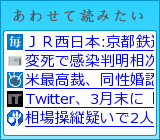[サンプルサイズ]
何かを実現するためのインフラを整備するための研究。このタイプの研究が好みだったりします。今回もアブストラクトのみ。
背景
P4P(成果連動型診療報酬)についてそれを導入するに際してそもそも,診療所毎のパフォーマンスの差を検出するだけの十分な症例数の診療をしているのか?
Medicareの患者において2005年の一年間で外来のプライマリケア医のコストや質の指標について診療所毎の10%の差を検出する為に必要な症例数があるか。
使用した指標 1)66−69歳のマンモグラフィ実施率、2)66−75歳の糖尿病患者におけるA1c測定率、3)予防可能な入院の発生率、4)心不全退院後の30日以内再入院率
1),2)において10%の差を検出するのに十分な症例数があったのは医師が11人未満の診療所では全診療所の10%未満。一方で50人以上の診療所では全ての診療所
3)4,)においては10%の差を検出するのに十分な症例数があった診療所は存在しなかった。
考察)
10%の差を検出するのに十分な症例数があったのは医師が11人未満の診療所では全診療所の10%未満。
成果連動型診療報酬を導入するには医師、診療所が納得のいく成果の評価方法でないといけない。
ソロプラクティスが中心の日本ではP4Pを導入するには症例数が不十分か?
医師50人以上なら,ということでまず病院からの導入となるか。そうするとまた診療所の質が後回しに。
10%でなく5%の差の検出ならばもう少し症例数は少なくて済むだろう。ではそこで証明された統計学的有意差は、診療報酬の差に反映してしかるべき臨床上意味のある差か、という問題は別。 (例えば診療所Aと診療所Bでマンモグラフィー実施率80%vs90%の場合と85%vs90%の場合など)
http://jama.ama-assn.org/cgi/content/short/302/22/2444?rss=1
Relationship of Primary Care Physicians' Patient Caseload With Measurement of Quality and Cost Performance
David J. Nyweide, PhD; William B. Weeks, MD, MBA; Daniel J. Gottlieb, MS; Lawrence P. Casalino, MD, PhD; Elliott S. Fisher, MD, MPH
JAMA. 2009;302(22):2444-2450.
Context Sufficient numbers of patients are necessary to generate statistically reliable measurements of physicians' quality and cost performance.
Objective To determine whether primary care physicians in the same physician practice collectively see enough Medicare patients annually to detect meaningful differences between practices in ambulatory quality and cost measures.
Design, Setting, and Patients Primary care physicians in the United States were linked to their physician practices using the Healthcare Organization Services database maintained by IMS Health. Patients who visited primary care physicians in the 2005 Medicare Part B 20% sample were used to estimateMedicare caseloads per practice. Caseloads necessary to detect 10% relative differences in costs and quality were calculated using national mean ambulatory Medicare spending, rates of mammography for women 66 to 69 years, and hemoglobin A1c testing for 66- to 75-year-olds with diabetes, preventable hospitalization rate, and 30-day readmission rate after discharge for congestive heart failure (CHF).
Main Outcome Measures Percentage of primary care physician practices with a sufficient number of eligible patients to detect a 10% relative difference in each performance measure.
Results Primary care physician practices had annual median caseloads of 260 Medicare patients (interquartile range [IQR], 135-500), 25 women eligible for mammography (IQR, 10-50), 30 patients with diabetes eligible for hemoglobin A1c testing (IQR, 15-55), and 0 patients hospitalized for CHF. For ambulatorycosts, mammography rate, and hemoglobin A1c testing rate, the percentage of primary care physician practices with sufficient caseloads to detect 10% relative differences in performance ranged from less than 10% of practices with fewer than 11 primary care physicians to 100% of practices with more than 50 primary care physicians. None of the primary care physician practices had sufficient caseloads to detect 10% relative differences in preventable hospitalization or 30-day readmission after discharge for CHF.
Conclusion Relatively few primary care physician practices are large enough to reliably measure 10% relative differences in common measures of quality and cost performance among fee-for-service Medicare patients.









0 コメント:
コメントを投稿